oil YAMAHA TTR50 2006 Betriebsanleitungen (in German)
[x] Cancel search | Manufacturer: YAMAHA, Model Year: 2006, Model line: TTR50, Model: YAMAHA TTR50 2006Pages: 390, PDF-Größe: 9.69 MB
Page 158 of 390
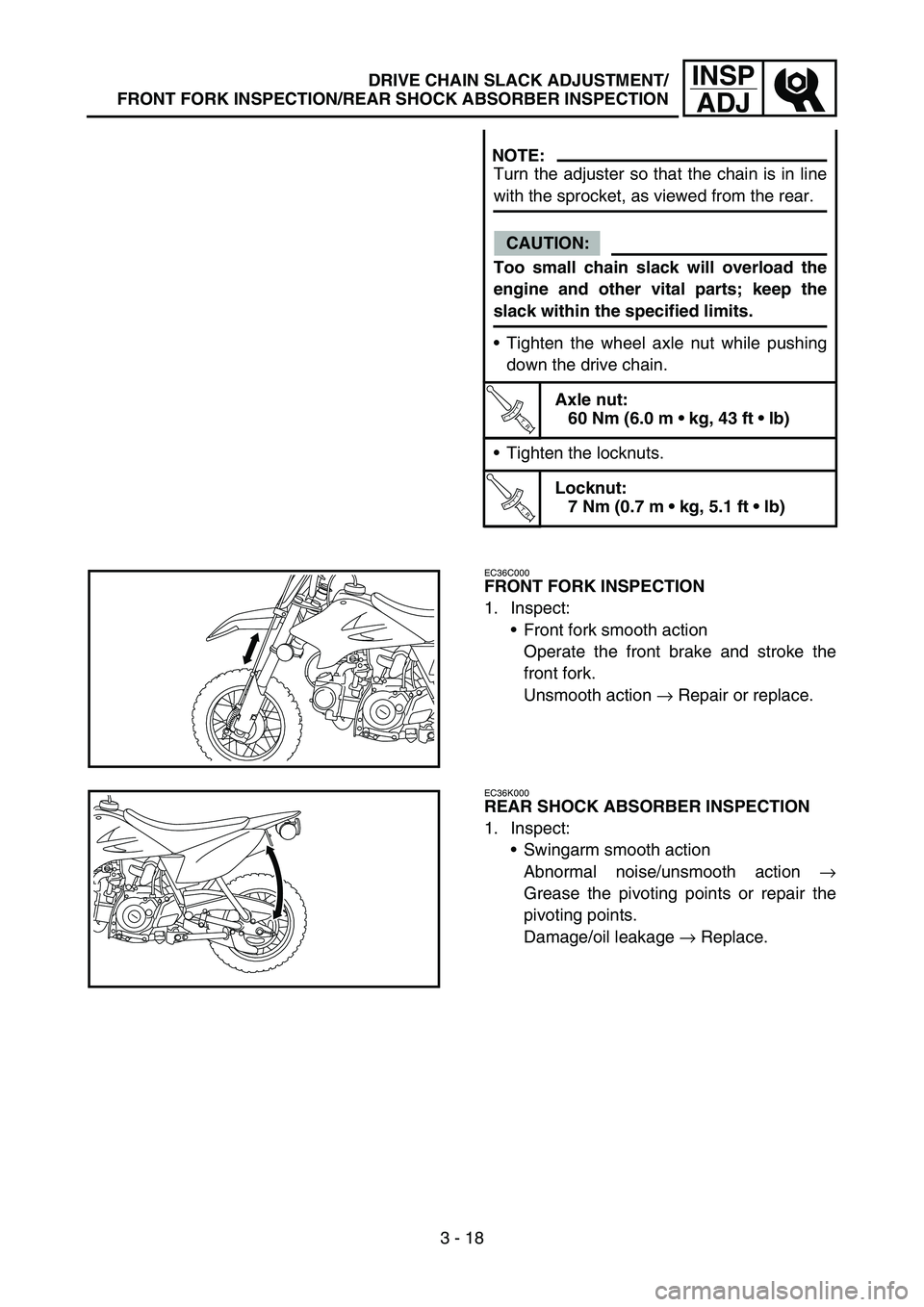
3 - 18
INSPADJDRIVE CHAIN SLACK ADJUSTMENT/
FRONT FORK INSPECTION/REAR SHOCK ABSORBER INSPECTION
NOTE:
Turn the adjuster so that the chain is in line
with the sprocket, as viewed from the rear.
CAUTION:
Too small chain slack will overload the
engine and other vital parts; keep the
slack within the specified limits.
Tighten the wheel axle nut while pushing
down the drive chain.
T R..
Axle nut:
60 Nm (6.0 m kg, 43 ft lb)
Tighten the locknuts.
T R..
Locknut:
7 Nm (0.7 m kg, 5.1 ft lb)
EC36C000
FRONT FORK INSPECTION
1. Inspect:
Front fork smooth action
Operate the front brake and stroke the
front fork.
Unsmooth action → Repair or replace.
EC36K000
REAR SHOCK ABSORBER INSPECTION
1. Inspect:
Swingarm smooth action
Abnormal noise/unsmooth action →
Grease the pivoting points or repair the
pivoting points.
Damage/oil leakage → Replace.
Page 161 of 390
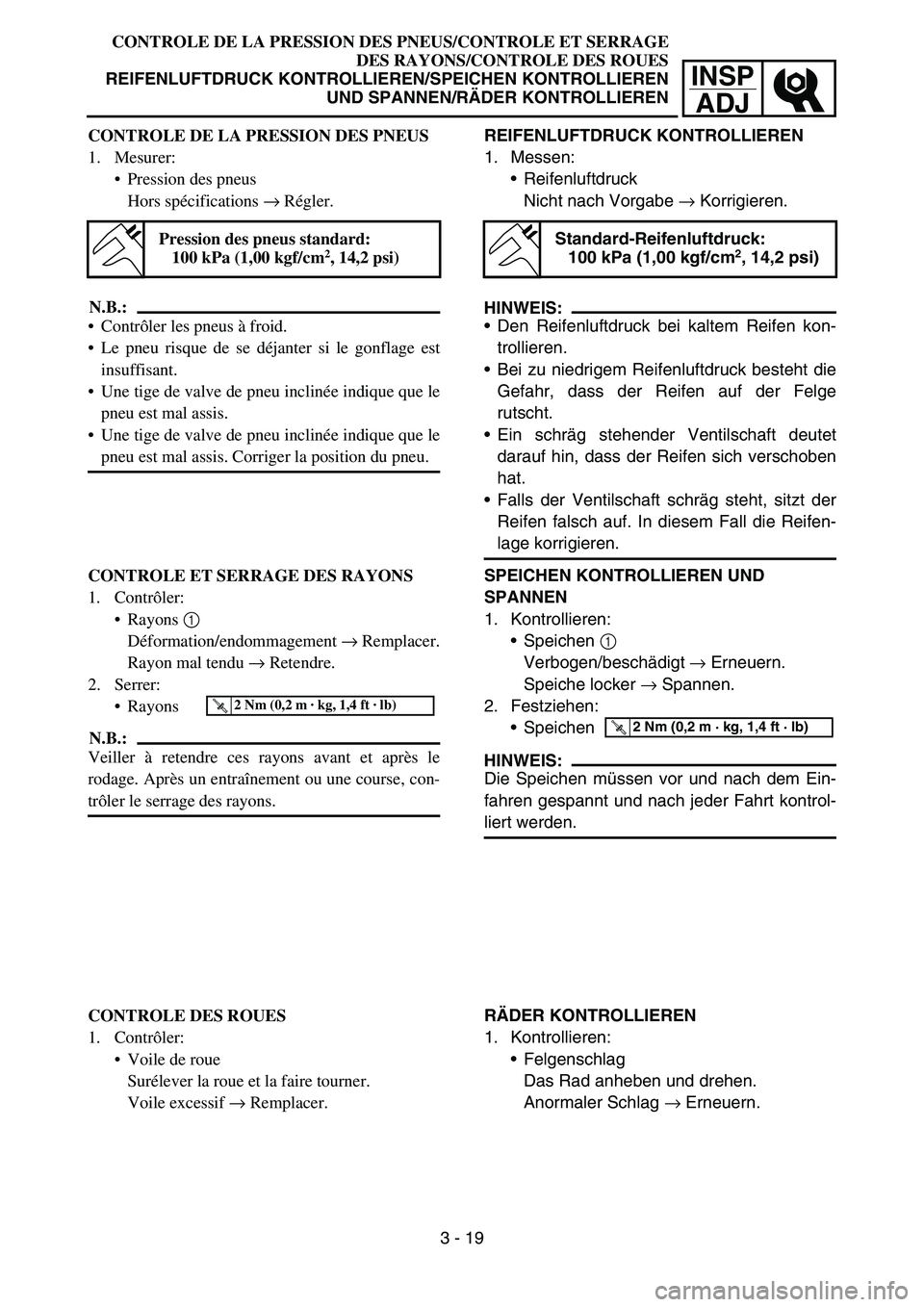
INSPADJ
CONTROLE DE LA PRESSION DES PNEUS/CONTROLE ET SERRAGE
DES RAYONS/CONTROLE DES ROUES
REIFENLUFTDRUCK KONTROLLIEREN/SPEICHEN KONTROLLIEREN UND SPANNEN/RÄDER KONTROLLIEREN
CONTROLE DE LA PRESSION DES PNEUS
1. Mesurer: Pression des pneus
Hors sp écifications → Régler.
N.B.:
Contr ôler les pneus à froid.
Le pneu risque de se d éjanter si le gonflage est
insuffisant.
Une tige de valve de pneu inclin ée indique que le
pneu est mal assis.
Une tige de valve de pneu inclin ée indique que le
pneu est mal assis. Corriger la position du pneu.
Pression des pneus standard:
100 kPa (1,00 kgf/cm2, 14,2 psi)
CONTROLE ET SERRAGE DES RAYONS
1. Contr ôler:
Rayons 1
D éformation/endommagement → Remplacer.
Rayon mal tendu → Retendre.
2. Serrer: Rayons
N.B.:
Veiller à retendre ces rayons avant et apr ès le
rodage. Apr ès un entra înement ou une course, con-
tr ôler le serrage des rayons.
T R..2 Nm (0,2 m · kg, 1,4 ft · lb)
CONTROLE DES ROUES
1. Contr ôler:
Voile de roue
Sur élever la roue et la faire tourner.
Voile excessif → Remplacer.
3 - 19REIFENLUFTDRUCK KONTROLLIEREN
1. Messen:
Reifenluftdruck
Nicht nach Vorgabe → Korrigieren.
HINWEIS:
Den Reifenluftdruck bei kaltem Reifen kon-
trollieren.
Bei zu niedrigem Reifenluftdruck besteht die
Gefahr, dass der Reifen auf der Felge
rutscht.
Ein schr äg stehender Ventilschaft deutet
darauf hin, dass der Reifen sich verschoben
hat.
Falls der Ventilschaft schr äg steht, sitzt der
Reifen falsch auf. In diesem Fall die Reifen-
lage korrigieren.
Standard-Reifenluftdruck: 100 kPa (1,00 kgf/cm2, 14,2 psi)
SPEICHEN KONTROLLIEREN UND
SPANNEN
1. Kontrollieren:
Speichen 1
Verbogen/besch ädigt → Erneuern.
Speiche locker → Spannen.
2. Festziehen: Speichen
HINWEIS:
Die Speichen m üssen vor und nach dem Ein-
fahren gespannt und nach jeder Fahrt kontrol-
liert werden.
T R..2 Nm (0,2 m · kg, 1,4 ft · lb)
R ÄDER KONTROLLIEREN
1. Kontrollieren: Felgenschlag
Das Rad anheben und drehen.
Anormaler Schlag → Erneuern.
Page 166 of 390
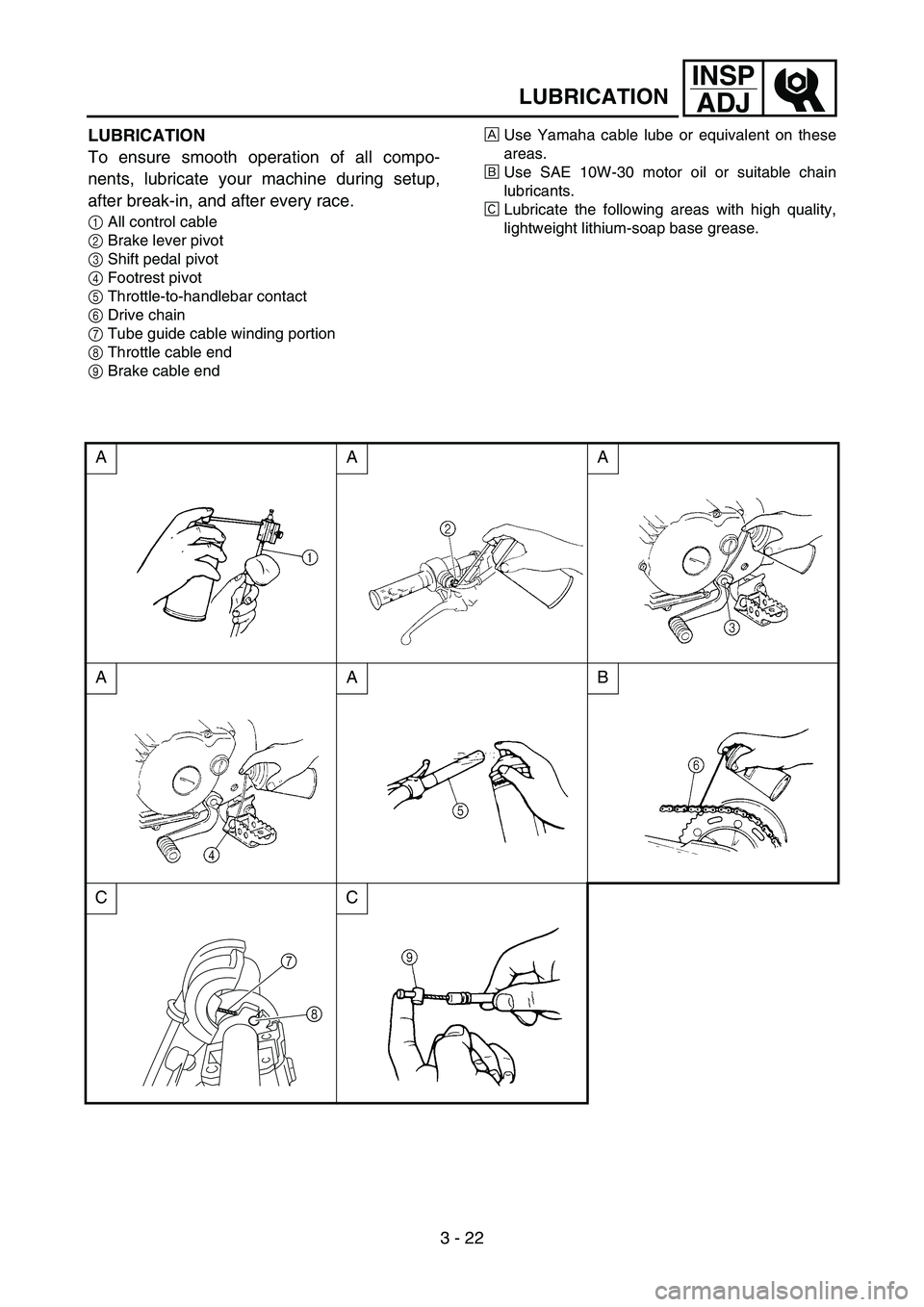
3 - 22
INSPADJ
LUBRICATION
LUBRICATION
To ensure smooth operation of all compo-
nents, lubricate your machine during setup,
after break-in, and after every race.
1 All control cable
2 Brake lever pivot
3 Shift pedal pivot
4 Footrest pivot
5 Throttle-to-handlebar contact
6 Drive chain
7 Tube guide cable winding portion
8 Throttle cable end
9 Brake cable end È
Use Yamaha cable lube or equivalent on these
areas.
É Use SAE 10W-30 motor oil or suitable chain
lubricants.
Ê Lubricate the following areas with high quality,
lightweight lithium-soap base grease.
AAA
AAB
CC
7 8
Page 170 of 390
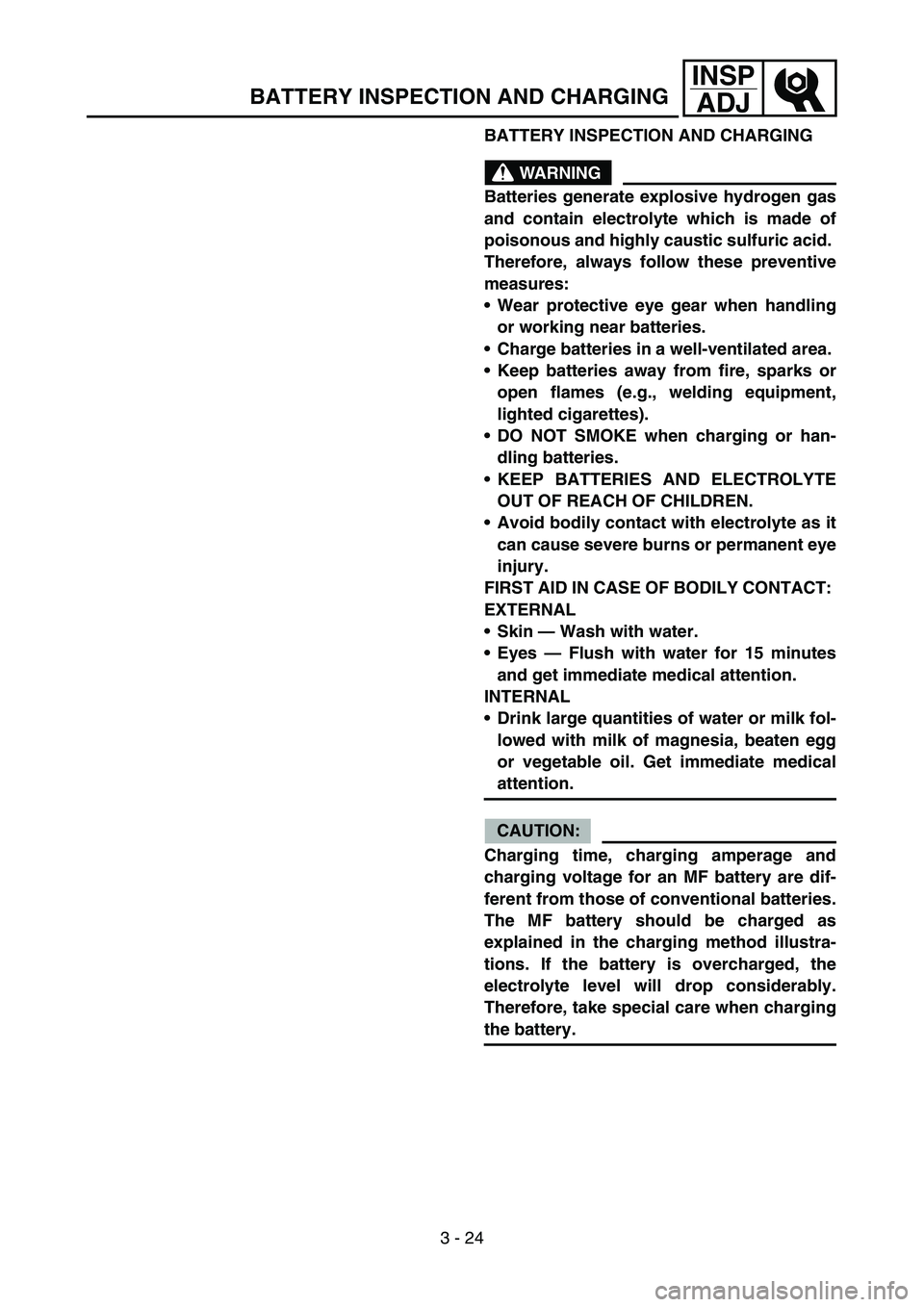
3 - 24
INSPADJ
BATTERY INSPECTION AND CHARGING
WARNING
Batteries generate explosive hydrogen gas
and contain electrolyte which is made of
poisonous and highly caustic sulfuric acid.
Therefore, always follow these preventive
measures:
Wear protective eye gear when handling
or working near batteries.
Charge batteries in a well-ventilated area.
Keep batteries away from fire, sparks or
open flames (e.g., welding equipment,
lighted cigarettes).
DO NOT SMOKE when charging or han-
dling batteries.
KEEP BATTERIES AND ELECTROLYTE
OUT OF REACH OF CHILDREN.
Avoid bodily contact with electrolyte as it
can cause severe burns or permanent eye
injury.
FIRST AID IN CASE OF BODILY CONTACT:
EXTERNAL
Skin — Wash with water.
Eyes — Flush with water for 15 minutes
and get immediate medical attention.
INTERNAL
Drink large quantities of water or milk fol-
lowed with milk of magnesia, beaten egg
or vegetable oil. Get immediate medical
attention.
CAUTION:
Charging time, charging amperage and
charging voltage for an MF battery are dif-
ferent from those of conventional batteries.
The MF battery should be charged as
explained in the charging method illustra-
tions. If the battery is overcharged, the
electrolyte level will drop considerably.
Therefore, take special care when charging
the battery.
BATTERY INSPECTION AND CHARGING
Page 212 of 390

4 - 13
ENGCYLINDER HEAD
4. Remove:Cylinder head
NOTE:
Loosen the bolts and nuts in their proper
loosening sequence.
Start by loosening each bolt and nut 1/2 turn
until all are loose.1
2
5
64
3
ASSEMBLY AND INSTALLATION
1. Install:
Cylinder head
2. Tighten: Nuts
Bolts
NOTE:
Apply the engine oil on the contact surfaces
of the nuts and copper washers.
Apply the engine oil on the thread and con-
tact surface of the bolts.
Follow the numerical order shown in the illus-
tration. Tighten the bolts and nuts in two
stages.
6
5
2
13
4
T R..22 Nm (2.2 m · kg, 16 ft · lb)
T R..10 Nm (1.0 m · kg, 7.2 ft · lb)
3. Install:
Camshaft sprocket 1
Installation steps:
Turn the crankshaft counterclockwise until
the “I” mark a on the rotor is aligned with
the stationary pointer b on the crankcase
cover.
Align the “I” mark c on the camshaft
sprocket with the stationary pointer d on
the cylinder head.
Fit the timing chain 2 onto camshaft
sprocket and install the camshaft sprocket
on the camshaft.
NOTE:
When installing the camshaft sprocket, keep
the timing chain as tense as possible on the
exhaust side.
b
a
1
2
c
d
Page 218 of 390

4 - 16
ENGCAMSHAFT AND ROCKER ARMS
REMOVAL POINTS
Rocker arm shaft
1. Remove:Rocker arm shafts
NOTE:
Use a slide hammer bolt 1 and weight 2 to
slide out the rocker arm shafts.
Slide hammer bolt:
YU-01083-1/90890-01083
Weight: YU-01083-3/90890-01084
INSPECTION
Camshaft
1. Measure:
Cam lobes length a and b
Out of specification → Replace.
Cam lobes length limit:
Intake:
a 25.328 mm (0.9972 in)
b 20.934 mm (0.8242 in)
Exhaust:
a 25.186 mm (0.9916 in)
b 20.947 mm (0.8247 in)
ASSEMBLY AND INSTALLATION
1. Apply:
Molybdenum disulfide oil
(onto the camshaft cam lobe)
Engine oil
(onto the camshaft bearing)
2. Install: Camshaft 1
Page 220 of 390
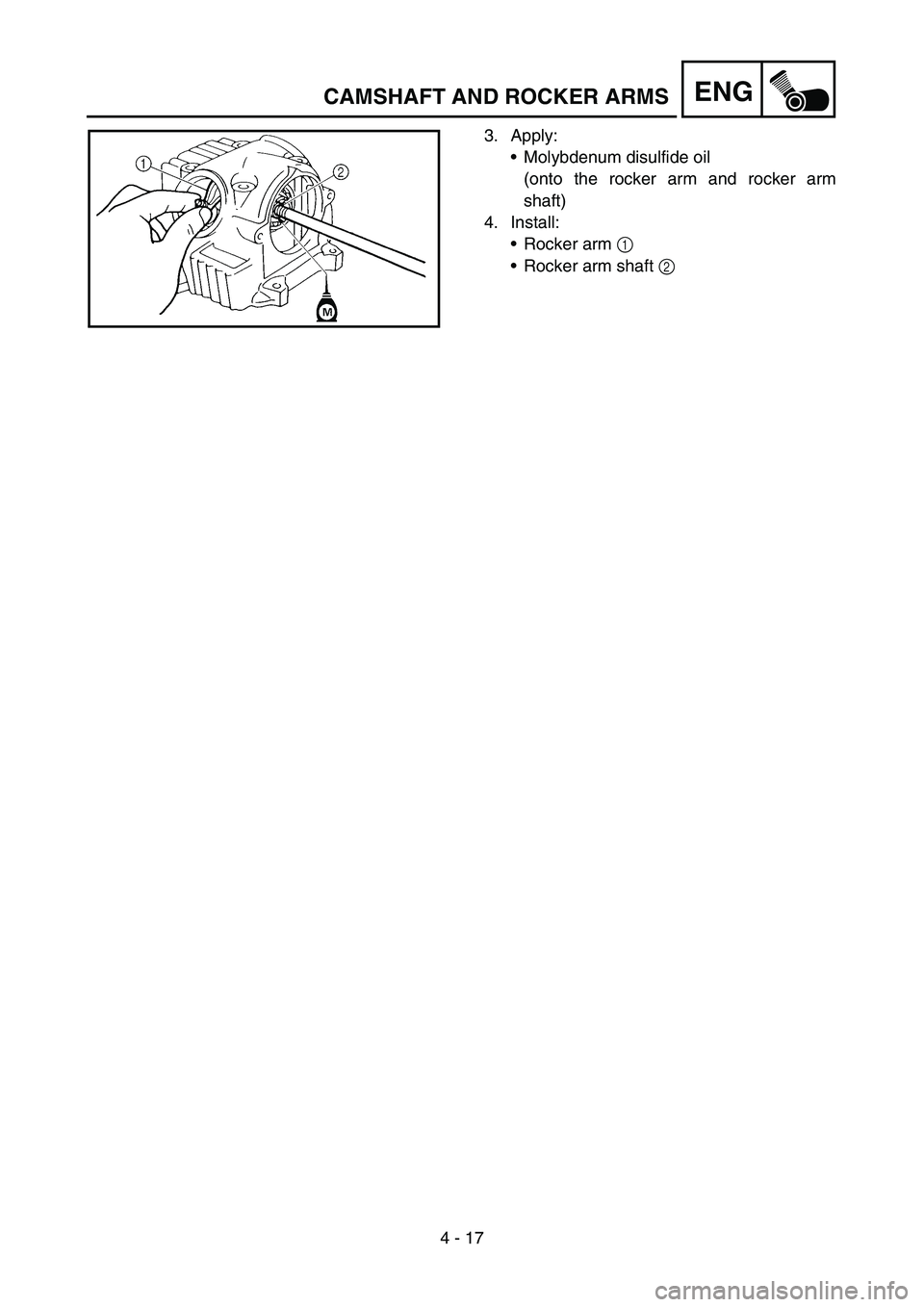
4 - 17
ENGCAMSHAFT AND ROCKER ARMS
3. Apply:Molybdenum disulfide oil
(onto the rocker arm and rocker arm
shaft)
4. Install: Rocker arm 1
Rocker arm shaft 2
Page 228 of 390

4 - 21
ENGVALVES AND VALVE SPRINGS
2. Lap:Valve face
Valve seat
NOTE:
After refacing the valve seat or replacing the
valve and valve guide, the valve seat and
valve face should be lapped.
Lapping steps:
Apply a coarse lapping compound to the
valve face.
CAUTION:
Do not let the compound enter the gap
between the valve stem and the guide.
Apply molybdenum disulfide oil to the
valve stem.
Install the valve into the cylinder head.
Turn the valve until the valve face and
valve seat are evenly polished, then clean
off all of the compound.
NOTE:
For best lapping results, lightly tap the valve
seat while rotating the valve back and forth
between your hands.
Apply a fine lapping compound to the
valve face and repeat the above steps.
NOTE:
After every lapping operation be sure to
clean off all of the compound from the valve
face and valve seat.
Apply Mechanic ’s blueing dye (Dykem) to
the valve face.
Install the valve into the cylinder head.
Press the valve through the valve guide
and onto the valve seat to make a clear
pattern.
Measure the valve seat width again. If the
valve seat width is out of specification,
reface and relap the valve seat.
Page 230 of 390

4 - 22
ENGVALVES AND VALVE SPRINGS
ASSEMBLY AND INSTALLATION
1. Apply:Molybdenum disulfide oil
(onto the valve stem and valve stem seal)
2. Install: Valve stem seats
Valves
Valve springs
Valve spring retainers
NOTE:
Install the valve springs with the larger pitch a
facing upwards.
bSmaller pitch
New
3. Install:
Valve cotters
NOTE:
While compressing the valve spring with a
valve spring compressor and attachment 1
install the valve cotters.
Valve spring compressor:
YM-04019/90890-04019
Valve spring compressor attach-
ment: YM-04108/90890-04108
4. To secure the valve cotters onto the valve
stem, lightly tap the valve tip with a piece of
wood.
CAUTION:
Hitting the valve tip with excessive force
could damage the valve.
Page 232 of 390

4 - 23
ENGCYLINDER AND PISTON
CYLINDER AND PISTON
Extent of removal: 1 Cylinder removal
2 Piston removal
Extent of removal Order Part name Q ’ty Remarks
CYLINDER AND PISTON
REMOVAL
Preparation for removal Cylinder head Refer to “CYLINDER HEAD ” section.
1 Timing chain guide (exhaust) 1
2 Cylinder 1
3 Dowel pin 2
4 Gasket 1
5 Piston pin clip 2 Use special tool.
Refer to “REMOVAL POINTS ”.
6 Piston pin 1
7Piston 1
8 Piston ring (top) 1
Refer to “REMOVAL POINTS ”.
9 Piston ring (2nd) 1
10 Oil ring 1
2
1